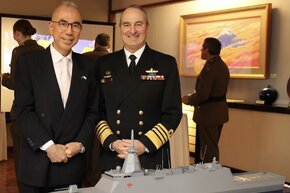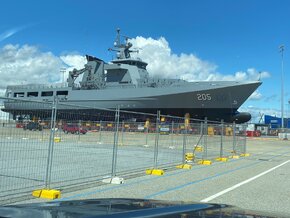I think they replaced Sea Sparrow with ESSM on all their destroyers. RAM's used as a CIWS on the Izumo & Mogami classes, but I've not heard that it's on other ships.Japan recently upped its ESSM production capabilities. Looks like they are committing to ESSM for other ships. I think previously RAM was their go to.
Royal Australian Navy Discussions and Updates 2.0
- Thread starter OPSSG
- Start date
The JMSDF has released what we would define as a “request for tender” for the integration of ESSM into their “non-AEGIS” ships including (presumably) Mogami and (it is assumed) upcoming FFM.I thought that Ise & Hyuga have ESSM, as well as the Murasame, Takanami, Akizuki & Asahi class. The old Asagiri class had Sea Sparrow: I don't know if they've changed to ESSM.
They test fired a new Japanese SAM (A-SAM) at sea in 2023. Don't know when it'll enter service. AFAIK all Japanese SAMs in service are land-based: their naval SAMs are all American so far. Japan tests new A-SAM system at sea - Naval News
Similar in concept no doubt to their previously stated intention to integrate NSM onto Mogami and (assumed) FFM as well.
Accordingly, despite many of the handwringers, things seem to be lining up quite nicely for RAN’s intended acquisition of Mogami FFM. Mk.45 127mm gun, ESSM, NSM, MH-60R Romeo and enablers (Hellfire, Mk.54 etc).
Learning the new ship, new CMS, radar systems etc will take some work, but as it is a direct replacement with the ANZAC Class with it’s 9LV / CEAFAR combo, the training impost must be at least “manageable”.
I would imagine spots are filling up fast on Japanese language courses though… Liaison spots would likely be highly sought after I imagine…
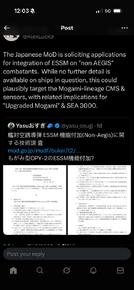
I think it is a compliment of both operating practices and technology.It's worth keeping in mind that crew requirements are primarily a function of each navy's operating practices, not a function of technology.
The more we learn about the Mogamis, the more apparent it is that there is no "secret sauce" around manning that the Japanese somehow magically discovered. What's really happening (as far as I can tell) is that the JMSDF cut crew numbers by accepting compromises in several key warfighting areas that would be unacceptable to other navies, starting with cuts to damage control and maintenance teams. They've also eliminated at-sea training by eliminating junior crew positions (which is how many navies handle career paths, by on-the-job apprenticeship).
There is nothing new here (IMHO) that hasn't already been tried in the last 20 years elsewhere, e.g. USN (LCS) and the RSN (Formidable class), with mixed success.
While Singapore certainly seems to be happy operating their frigates with core crews of only 71, it's worth noting that when the French Navy tried to do the same with basically the same technology in their FREMM frigates (built by the same yard), they quickly found that they had to increase core crews from 94 to 109 to reduce fatigue during longer stints at sea. And even that wasn't enough for "combat" deployments... so now following a decade of operational experience they are increasing their frigate core crews (again) to 131-144 sailors... TWICE Singapore's baseline, and 40-50% over their initial starting point for the FREMMs.
So it all comes down to watchkeeping practices (are you preparing for 4-6 month long combat deployments to the Red Sea or just patrolling home waters?), maintenance & damage control practices, how many boarding teams you need, whether you want junior crew members to learn only ashore or by being embedded inside an operational crew etc. To illustrate with some numbers, a FREMM's combat operations team is 70-80 sailors. That's what's considered necessary to maintain permanent 24/7 watches in all warfare areas for 30+ days at sea. Then you have a "platform" crew of ~30 sailors to handle engineering, damage control watches, as well as ongoing maintenance. Finally you also need ~30 sailors to support the crew (everything from cooks to admin to boarding teams).
You can of course cut all that. Fewer cooks & admin, no dedicated boarding teams, no dedicated damage control watch or ongoing maintenance. Cut watchstanders from 3 watches to 2 watches. Skimp on your SIGINT and sonar watch - maybe let a computer do the job for you. Eliminate dedicated weapons crews who would reload guns and decoys in the middle of a firefight. No doctor on board, no one to handle logistics during foreign port calls or to manage spare parts, no secretary to handle administrative duties. No problem, core crew is now well under 100! Good luck maintaining combat readiness during a 4-6 month deployment to the Red Sea or South China Sea...
A ship's crew already changes depending on its activity. It varies considerably depending on the deployment. During my time on ANZACs we could vary from 160 up to over 240 people.
I suspect Mogamis work on a similar principle. They have beds I understand for upwards of 140 people, and we will have additional trainees above the official number. Extra crew will be embarked for differing missions
We never had a doctor, except on long overseas deployments. For the majority of the time, a medic (similar qualifications to a civilian ambulance crew) is the senior medical person onboard. They are very good and to be honest I would rather be treated for an injury by a military medic than a doctor. They know how to stop bleeding fast.
I remember there were similar arguments regarding crew size reductions when we went from the Charles Adams and River classes down to the Hobart, ANZAC and Perry class crew sizes. I think similar concerns were mounted then regarding crew fatigue, full ship functionality and damage control capability.
All in all the newer classes continued to operate, albeit differently, but to the same effect.
Activities like damage control evolve. The practices used on a Charles Adams were very different to an ANZAC, which will be different to a Mogami. The changes bring about a lot of new strengths, but sometimes some new weaknesses as well. The art is how crews adapt to these changes to harness the strengths and mitigate the weaknesses.
Going Boeing
Well-Known Member
Any idea what their yearly production rate will be? I saw the US only received 500 since 2022Japan recently upped its ESSM production capabilities. Looks like they are committing to ESSM for other ships. I think previously RAM was their go to.

ESSM Blk 2 Delivery
In case you missed it, here’s a brief update on ESSM Blk 2 missile deliveries. According to DOT&E[1], ESSM production missiles began deliv...
A follow up post showed each AB would only receive 7 ESSM's , if they only had 500 ESSM's.
Only 7x Block II’s averaged out across the entire fleet being at sea at the same time and not counting the thousands strong inventory of Block I…Any idea what their yearly production rate will be? I saw the US only received 500 since 2022

ESSM Blk 2 Delivery
In case you missed it, here’s a brief update on ESSM Blk 2 missile deliveries. According to DOT&E[1], ESSM production missiles began deliv...navy-matters.blogspot.com
A follow up post showed each AB would only receive 7 ESSM's , if they only had 500 ESSM's.
Things aren’t quite as grim as they are made out, but missile production at politically acceptable peace-time production rates has put us in this situation…
Japan establishing an ESSM production line might be why we have not seen any movement from our own Government on ESSM production.Any idea what their yearly production rate will be? I saw the US only received 500 since 2022

ESSM Blk 2 Delivery
In case you missed it, here’s a brief update on ESSM Blk 2 missile deliveries. According to DOT&E[1], ESSM production missiles began deliv...navy-matters.blogspot.com
A follow up post showed each AB would only receive 7 ESSM's , if they only had 500 ESSM's.
Hard to justify two lines in SE Asia, provided Japan has the capacity we need as well.
We may get the added benefit of increased parts supply into their production line.
Nuship Pilbara was rolled out of the shed today, cheers.
Attachments
-
326.2 KB Views: 45
How long before acceptance you think, mid-late 2026?Nuship Pilbara was rolled out of the shed today, cheers.
Arafuras do as well.Japan recently upped its ESSM production capabilities. Looks like they are committing to ESSM for other ships. I think previously RAM was their go to.
LHDs, AOR I believe have 9LV. I thought Choules maybe too, but apparently not.. HMAS Choules fitted with CEAFAR radar - Australian Defence Magazine
That would be my guess.How long before acceptance you think, mid-late 2026?
Cheers Pusser.That would be my guess.
Do you know if all OPVs will be delivered before the first LCH?
Both Marles and Conroy have stated 2029 but I’m hearing the aim is early-mid 2028.
Todjaeger
Potstirrer
It was my understanding that the Arafura-class OPV has elements of the 9LV, including workstations/interfaces, but not a complete 9LV system. If this is an accurate understanding, that would negatively impact any efforts to expand the OPV's capabilities in ways which would require greater electronics or computing capability or expanded use/participation in datalinks. Can anyone confirm whether this is correct or not?Arafuras do as well.
A quibble: Japan is in NE Asia.Japan establishing an ESSM production line might be why we have not seen any movement from our own Government on ESSM production.
Hard to justify two lines in SE Asia, provided Japan has the capacity we need as well.
Totting up the ships, I think the JMSDF has about 1000 Mk41 cells on 28 ships, & a couple of hundred Mk 48 on 7 other ships & some of the 28. Of course, most of those cells will hold other missiles, but if they all put to sea with a full war load that'd probably include several hundred ESSM.
I suspect that Japanese production will be on a bigger scale than Australian would be likely to be.
Anyone questioning the cost and glacial pace and schedule of RAN ship construction. Singapore just built an 8000 tonne frigate and took 12 months from keel laying to launch. The first of a planned 6 and is planned to be commissioned into service in 2028. The ship cost is around $200m per ship.
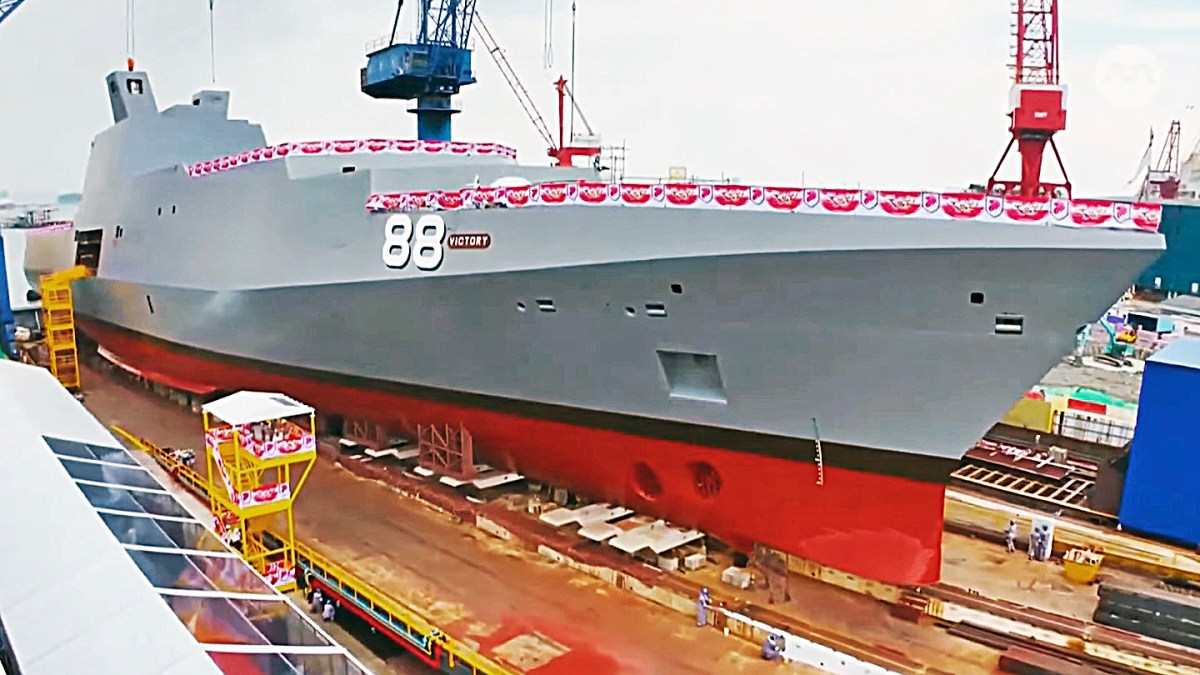
 www.twz.com
www.twz.com

 asiapacificdefencereporter.com
asiapacificdefencereporter.com

Singapore Launches Its Biggest And Most Capable Warship Ever
Planned as hybrid frigates and drone motherships, the Multi-Role Combat Vessels will be able to project naval power further, and for longer, than previous Singaporean warships. Planned as hybrid frigates and drone motherships, the Multi-Role Combat Vessels will be able to project naval power...

ST Engineering bags estimated $1.2 billion deal to build multirole combat vessels for Singapore Navy - APDR
Following the announcement of the new contract signed between Singapore and ST Engineering to build multirole combat vessels, Akash Pratim Debbarma, Defense Analyst at GlobalData, offered his view:
It was my understanding that the Arafura-class OPV has elements of the 9LV, including workstations/interfaces, but not a complete 9LV system. If this is an accurate understanding, that would negatively impact any efforts to expand the OPV's capabilities in ways which would require greater electronics or computing capability or expanded use/participation in datalinks. Can anyone confirm whether this is correct or not?
The nature of 9LV is that it is modular and sizeable according to need, so there is really no such thing as a “complete” 9LV System. Each of the ANZACS, Hobarts, AORs, LHDs and OPVs has a uniquely tailored system, albeit with much commonality of elements. Obviously, the one in a Hobart is going to be more capable than the one in an Arafura.
Todjaeger
Potstirrer
TBH no, not really. I do question the TWZ article as well as the writer of the article. The capability claim sounds like it might be a bit beyond hyperbolic, particularly when one keeps in mind the claimed price tag per vessel.Anyone questioning the cost and glacial pace and schedule of RAN ship construction. Singapore just built an 8000 tonne frigate and took 12 months from keel laying to launch. The first of a planned 6 and is planned to be commissioned into service in 2028. The ship cost is around $200m per ship.

Singapore Launches Its Biggest And Most Capable Warship Ever
Planned as hybrid frigates and drone motherships, the Multi-Role Combat Vessels will be able to project naval power further, and for longer, than previous Singaporean warships. Planned as hybrid frigates and drone motherships, the Multi-Role Combat Vessels will be able to project naval power...www.twz.com

ST Engineering bags estimated $1.2 billion deal to build multirole combat vessels for Singapore Navy - APDR
Following the announcement of the new contract signed between Singapore and ST Engineering to build multirole combat vessels, Akash Pratim Debbarma, Defense Analyst at GlobalData, offered his view:asiapacificdefencereporter.com
That pricetag of $200 mil. per vessel is less than the cost for a set of Aegis CMS and SPY arrays for a single vessel, never mind anything else a warship requires like a hull, weapons, machinery, etc.
Now I have not been able to work out what the cost per vessel was for Sinagpore's Formidable-class frigates, Taiwan's Kang Ding-class frigates, another derivative of DCNS's La Fayette-class frigate, cost roughly $300 mil. per vessel back in the early 1990's. This is the rough number I get when substracting some of the funding involved in the frigate purchase which might have actually been spent on kickbacks and other corrupt purposes. Otherwise, then one would be talking about $500 mil. per vessel, and again this would be in 1990's dollars, not 2025 dollars.
That makes me thing that whatever Singapore is getting for $200 mil. is not really that capable as a warship, or that is 'just' the price for the hull and perhaps the design, rather than an actual, completed warship. Given that the article mentions that now launched vessel will move to a yard for further outfitting, it is quite possible that a good deal of kit was not included in the pricetag.
Also, if one keeps in mind that OPV's typically run about $100 mil. and lack the sort of sophisticated sensors and CMS for a proper warship, that can provide a sort of base line when talking price.
Lastly, the article itself mentions the class including lead ship are planned for delivery starting in 2028 and onward. This means quite a bit of work remains to be done.
Honestly I don't know mate, there isn't any info floating around over here regarding possible dates. Assuming the LCH's are planned to be built at CIVMEC, the OPV's would mostly have to be out of the way for that to happen.Cheers Pusser.
Do you know if all OPVs will be delivered before the first LCH?
Both Marles and Conroy have stated 2029 but I’m hearing the aim is early-mid 2028.
Some detail on the AusCMS fit on the Arafura, as well as other deets on the class and program I hadn’t seen before below…The nature of 9LV is that it is modular and sizeable according to need, so there is really no such thing as a “complete” 9LV System. Each of the ANZACS, Hobarts, AORs, LHDs and OPVs has a uniquely tailored system, albeit with much commonality of elements. Obviously, the one in a Hobart is going to be more capable than the one in an Arafura.
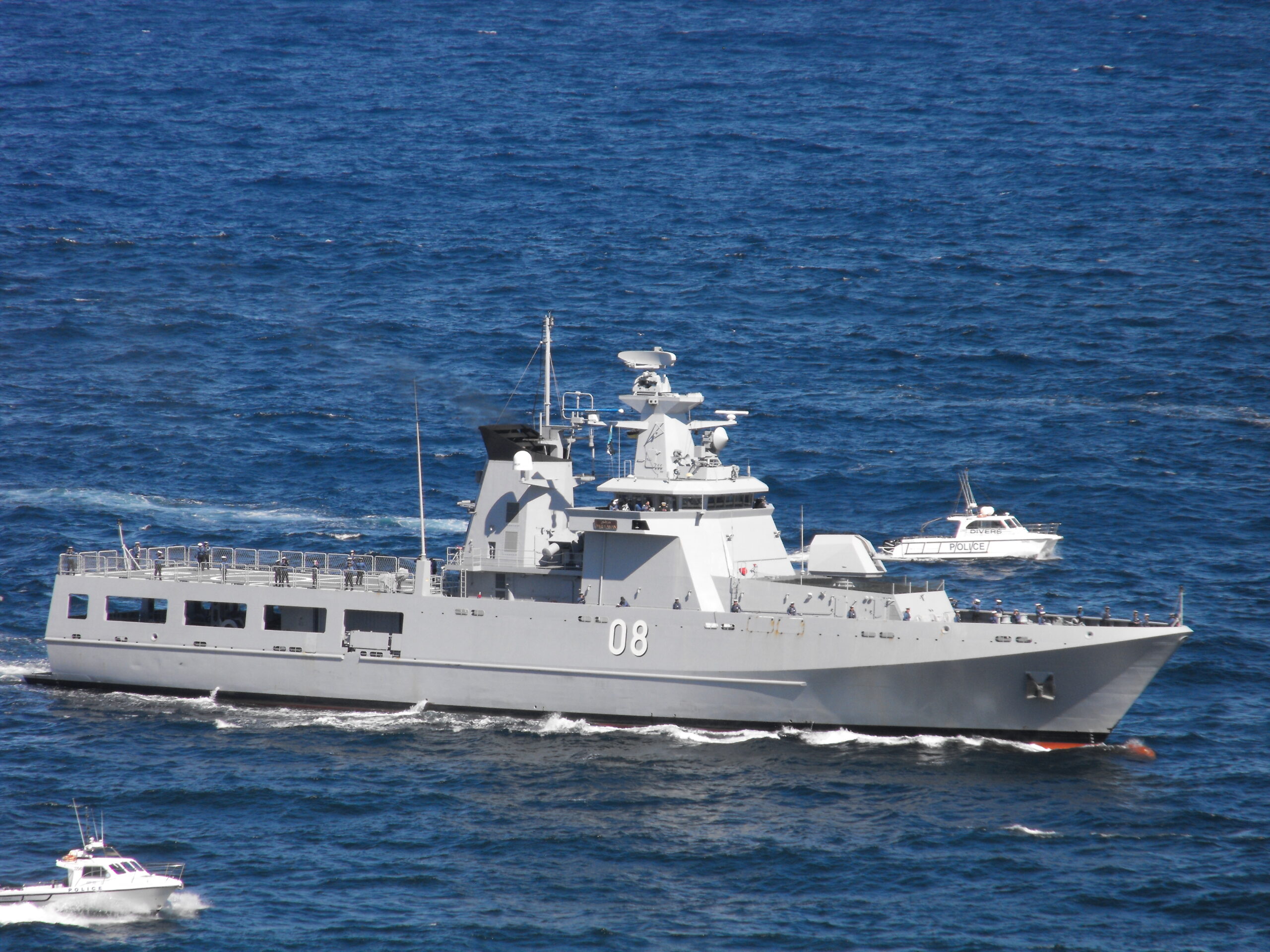
Royal Australian Navy Welcomes HMAS Arafura as New Arafura-Class OPV - DEFENSE-AEROSPACE
Australia commissions HMAS Arafura OPV, boosting patrol range and modular mission capability across the Indo-Pacific.
 www.defense-aerospace.com
www.defense-aerospace.com

